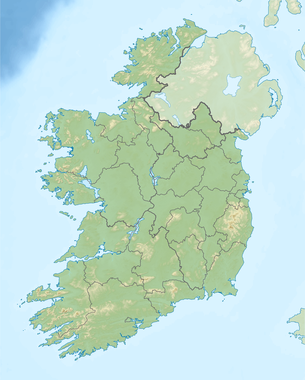Battle of Macroom
Coordinates: 51°54′16″N 8°57′25″W / 51.904354°N 8.956947°W
| Battle of Macroom | |||||||
|---|---|---|---|---|---|---|---|
| Part of the Irish Confederate Wars | |||||||
| |||||||
| Belligerents | |||||||
|
|
| ||||||
| Commanders and leaders | |||||||
|
|
| ||||||
| Strength | |||||||
|
4,000 foot 300 horse[1] | 1,500 horse[1] | ||||||
| Casualties and losses | |||||||
| Several hundred killed[1] | Low | ||||||

The Battle of Macroom was a skirmish fought on 10 May 1650, near Macroom, County Cork, in southern Ireland, during the Cromwellian conquest of Ireland. An English Parliamentarian force under Roger Boyle, (Lord Broghill), defeated an Irish Confederate force under David Roche.
Background[]
Boyle had taken Cork for the English Parliamentarians by inducing its English Royalist garrison to defect to the Parliamentary side, which they had served until 1648. This was a major help to Oliver Cromwell's campaign in Ireland, as it secured for him most of Munster and its port towns. The Irish and Royalist troops in the province retreated to western County Kerry, which is a natural stronghold due to its remote and mountainous terrain.[citation needed]
Battle[]
David Roche, an Irish officer, organised an offensive, out of Kerry with 1,400 men in May 1650, in an effort to relieve the Siege of Clonmel. Cromwell sent Boyle to intercept Roche's force with 1,500 infantry and 500 cavalrymen. When Roche realised that he was being pursued, he turned back. Rather than let the Irish force escape, Boyle followed them with his cavalry alone. He caught them at Macroom on 10 May. The English surprised the Irish with a cavalry charge before they could form up for battle and routed them. Several hundred Irish soldiers were killed. The Parliamentarian's losses were light. Roche's force broke up in disorder and fell back towards the mountains of Kerry.[1][2]
Aftermath[]
The following day, Boyle besieged and took Carrigadrohid castle. His men had taken Boetius MacEgan, the Catholic Bishop of Ross prisoner and warned the garrison that they would kill him unless they surrendered. MacEgan told the garrison not to surrender and was then hanged in view of the castle walls. The garrison surrendered shortly afterwards but were allowed to march away unmolested.[1][3]
Citations[]
- ^ a b c d e Bagwell (1909), p. 223.
- ^ Carte (1851), pp. 538–539.
- ^ Carte (1851), p. 539.
References[]
- Bagwell, Richard (1909), Ireland under the Stuarts and under the Interregnum, vol. 2, London: Longmans, Green, and Co.
- Carte, Thomas (1851), The Life of James Duke of Ormond, vol. 3 (new ed.), Oxford: Oxford University Press
Further reading[]
- Ó Siochrú, Mícheál (1999), Confederate Ireland, 1642-1649: A Constitutional and Political Analysis, Four Courts Press, ISBN 9781851824007
- Wheeler, James Scott (1999), Cromwell in Ireland, St. Martin’s Press, ISBN 9780312225506
- 1650 in Ireland
- Battles of the Irish Confederate Wars
- Battles involving England
- History of County Cork
- Conflicts in 1650
- Macroom
